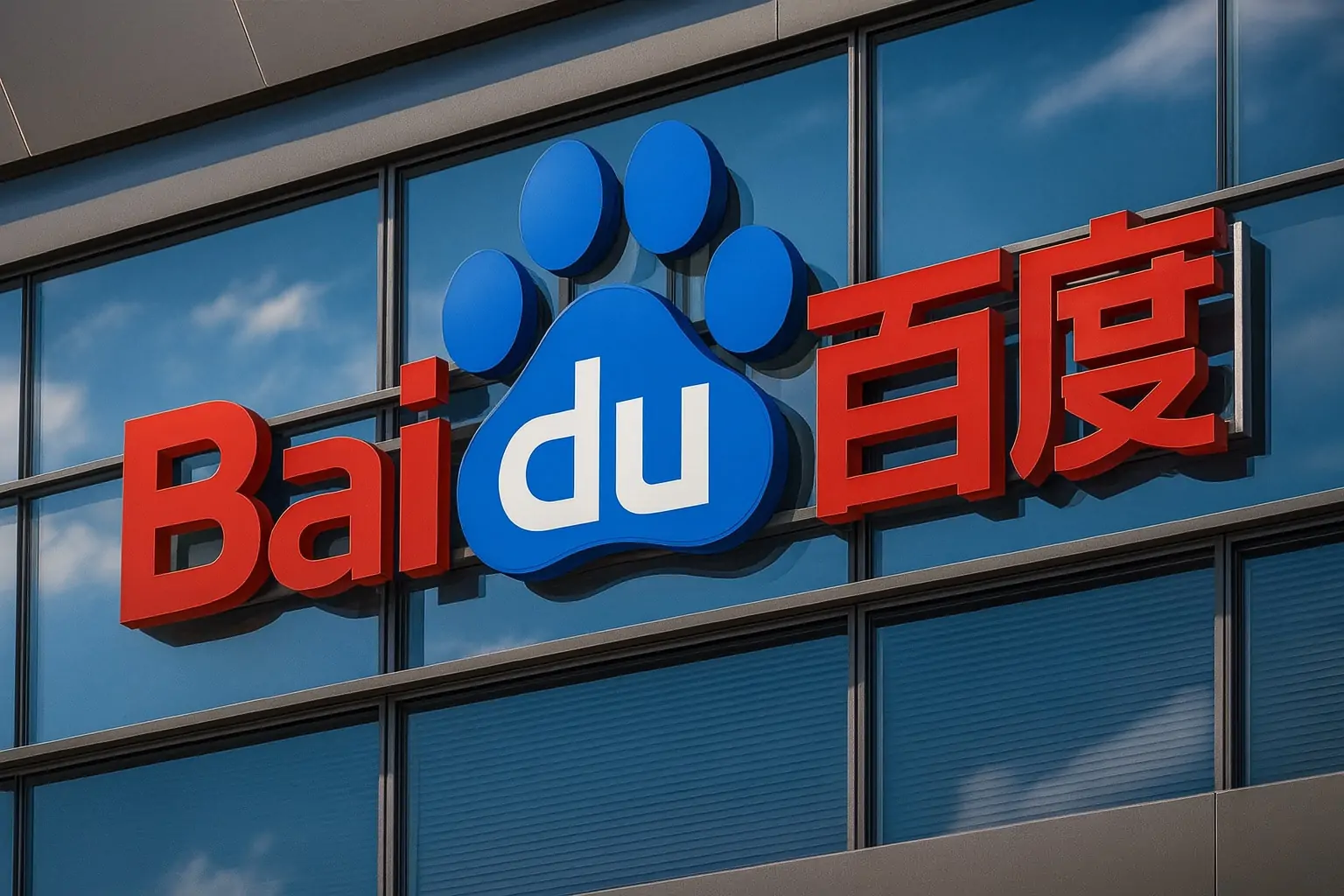Baidu, Inc. (NASDAQ: BIDU), China’s dominant search engine and a fast‑moving AI heavyweight, reported third‑quarter 2025 results that highlight a company in the middle of a painful but deliberate transformation.
Revenue declined as legacy online ads slumped, but Baidu still delivered a strong earnings beat on the back of its AI cloud, autonomous‑driving platform Apollo Go, and a rapidly expanding portfolio of AI‑powered services. [1]
Key Takeaways for Baidu (BIDU) Today
- Revenue down, but ahead of the Street
- Q3 2025 revenue: RMB 31.2 billion (~$4.38 billion), down 7% year over year but slightly above most analyst estimates around RMB 30.7–31.3 billion. [2]
- Heavy GAAP loss driven by a huge impairment
- Operating loss: RMB 15.1 billion (~$2.12 billion).
- Net loss attributable to Baidu: RMB 11.2 billion (~$1.58 billion), or RMB –33.88 (–$4.76) per ADS, mostly due to a RMB 16.2 billion impairment of long‑lived assets.
- Excluding the impairment, Baidu says it would have reported RMB 2.6 billion (~$359 million) in net income. [3]
- Non‑GAAP earnings comfortably beat expectations
- Non‑GAAP net income: RMB 3.8 billion (~$530 million).
- Non‑GAAP diluted EPS:RMB 11.12 per ADS, versus analyst expectations near RMB 7.8–8.4. [4]
- Ad business slumps, AI businesses surge
- Online marketing revenue: RMB 15.3 billion, down 18% YoY amid weak Chinese advertising demand.
- Non‑online marketing revenue (largely AI Cloud & other services): RMB 9.3 billion, up 21% YoY. [5]
- AI‑powered businesses cross RMB 10 billion in quarterly revenue
- Baidu’s new AI‑native reporting view shows AI‑powered businesses at ~RMB 10 billion revenue, up over 50% YoY, with:
- AI Cloud Infra: RMB 4.2B, +33% YoY
- AI Applications: RMB 2.6B, +6% YoY
- AI‑native marketing services: RMB 2.8B, +262% YoY. [6]
- Baidu’s new AI‑native reporting view shows AI‑powered businesses at ~RMB 10 billion revenue, up over 50% YoY, with:
- Apollo Go hits 3.1 million fully driverless rides in Q3 and goes global
- 3.1 million fully driverless rides in Q3 2025, +212% YoY.
- 17+ million cumulative rides by November 2025; weekly driverless rides >250,000.
- New fully driverless commercial permit in Abu Dhabi, with plans to scale to hundreds of robotaxis by 2026, and a strategic partnership with PostBus in Switzerland. [7]
- Stock reaction: volatile but within recent range
- Ahead of the report, BIDU had slid sharply over the last week but was up around 30% over the last three months and 33% over the last 12 months. [8]
- Today, Baidu’s U.S. shares are trading in the low $110s, inside a 52‑week range of $74.71–$149.51, as investors digest the mix of earnings strength and revenue pressure. [9]
Earnings Overview: A Tale of Two P&Ls
On the surface, Baidu’s Q3 2025 numbers look grim: a mid‑single‑digit revenue decline and a multibillion‑yuan GAAP loss. But the story shifts dramatically once you separate one‑off impairments from the underlying AI‑driven operations.
Revenue and Profitability
- Total revenue: RMB 31.2B (–7% YoY).
- Baidu Core revenue: RMB 24.7B (–7% YoY).
- iQIYI revenue: RMB 6.7B (–8% YoY). [10]
The heavy GAAP loss was almost entirely driven by a RMB 16.2B impairment of long‑lived assets, which pushed operating income from a modest profit last year to a RMB 15.1B operating loss this quarter. Excluding that impairment: [11]
- Baidu says operating income would have been RMB 1.1B (Baidu Core: RMB 1.2B).
- Net income attributable to Baidu would have been RMB 2.6B, turning the headline loss into a solid profit.
On a non‑GAAP basis, which strips out the impairment and other items:
- Non‑GAAP operating income: RMB 2.2B.
- Non‑GAAP net income: RMB 3.8B.
- Non‑GAAP EPS: RMB 11.12 per ADS – a 40%+ beat vs typical analyst expectations. [12]
This explains why several analyst and financial outlets are describing Q3 as a “profitability beat despite top‑line pressure”, emphasizing Baidu’s cost discipline and operational leverage in its AI businesses. [13]
Advertising Slump vs. AI & Cloud Growth
Baidu is still very much exposed to China’s macro slowdown. Management and outside coverage highlight weak corporate marketing budgets, particularly in sectors hit hardest by the country’s property downturn and ongoing U.S.–China trade tensions. [14]
Legacy Ads Under Pressure
- Online marketing (ads): RMB 15.3B, –18% YoY.
- This segment includes Baidu Search’s traditional paid links and display ads — the core of Baidu’s original business model.
- Reuters notes that cautious advertisers are cutting spend amid prolonged economic uncertainty, directly hitting Baidu’s ad‑heavy search platform. [15]
Non‑Marketing Revenue and AI Cloud Cushion the Blow
The bright spot is everything non‑advertising:
- Non‑online marketing revenue: RMB 9.3B, +21% YoY, driven mainly by AI Cloud. [16]
- Within the new AI‑powered business view:
- AI Cloud Infra: RMB 4.2B, +33% YoY.
- AI Applications (Wenku, Baidu Drive, Digital Employee, etc.): RMB 2.6B, +6% YoY.
- AI‑native Marketing Services (AI agents, digital humans): RMB 2.8B, +262% YoY. [17]
In comments released with the earnings statement, CFO Haijian He stressed that AI Cloud growth is “cushioning” the ad downturn, and that AI‑powered revenue — now around RMB 10B per quarter — is growing over 50% year over year and forming a “solid foundation for long‑term growth.” [18]
In other words, Baidu’s old ad‑based internet business is shrinking, but its AI infrastructure and applications are scaling fast enough to keep overall revenue only moderately negative — and significantly more profitable on a run‑rate basis than the headline GAAP loss suggests.
Apollo Go: Robotaxis Move From Pilot to Global Business
If there’s one operational metric that jumps off the page, it’s Apollo Go.
Baidu’s autonomous ride‑hailing service is no longer a futuristic side experiment; it’s a high‑growth, commercial business that management clearly sees as a strategic pillar.
Q3 2025 Driving Metrics
From Baidu’s own disclosure: [19]
- 3.1 million fully driverless rides in Q3 2025 alone,
- +212% YoY, up from 148% growth last quarter.
- Weekly fully driverless rides in October exceeded 250,000.
- By November, cumulative public rides surpassed 17 million.
- The fleet has logged 240 million autonomous kilometers, including 140 million fully driverless kilometers, across 22 cities.
Global Expansion: Abu Dhabi & Switzerland
Apollo Go’s expansion is increasingly international:
- Abu Dhabi, UAE
- Apollo Go and local partner AutoGo have secured one of the emirate’s first fully driverless commercial permits, moving from testing to fully unmanned robotaxi service.
- The partners plan to scale to hundreds of vehicles by 2026, aiming to build Abu Dhabi’s largest driverless fleet. [20]
- Switzerland
- Baidu announced a partnership with PostBus, the country’s leading public transport operator, to launch on‑demand autonomous mobility services in eastern Switzerland, with trial operations starting later this year. [21]
Domestically, Baidu says Apollo Go is now 100% fully driverless in every mainland Chinese city where it operates, including Beijing, Shanghai, Shenzhen, Wuhan, and others — an important claim in the global race against Waymo, Cruise, and other robotaxi providers. [22]
Generative AI Push: ERNIE 5.0, ERNIE 4.5 Thinking, and Kunlun Chips
Q3 earnings land just days after Baidu World 2025, where the company rolled out major upgrades to its AI stack. Together, they frame why Baidu keeps plowing capital into AI despite short‑term profit pain.
ERNIE 5.0: A 2.4‑Trillion‑Parameter Omni‑Modal Foundation Model
At Baidu World, the company unveiled ERNIE 5.0, described as a “natively omni‑modal” foundation model that jointly handles text, images, audio, and video. According to Chinese and company reports, ERNIE 5.0 packs around 2.4 trillion parameters and is designed for advanced multimodal understanding, creative generation, and complex reasoning tasks. [23]
The model is already:
- Available to consumers through ERNIE Bot.
- Offered to enterprise customers via Baidu AI Cloud’s Qianfan MaaS platform. [24]
Baidu also announced:
- Upgrades to digital human tech and the Miaoda/MeDo no‑code AI app builders.
- The GenFlow 3.0 general AI agent, now boasting over 20 million users, which Baidu calls “the world’s largest general‑purpose agent.” [25]
ERNIE 4.5 Thinking: Baidu Goes Open Source
In a move clearly aimed at developers and enterprises wanting more control, Baidu has open‑sourced ERNIE 4.5 Thinking, a compact multimodal model aimed at reasoning, coding, and image‑aware tasks.
Independent early coverage describes the model as: [26]
- Competitive with the latest GPT‑ and Gemini‑class models on several coding and reasoning benchmarks.
- Much more efficient in hardware footprint, making it practical for on‑premises or edge deployment.
This open‑source strategy widens Baidu’s appeal beyond China and positions the company as a serious player in the global open‑model ecosystem, especially for organizations with strict data residency and governance requirements.
Kunlun M100 & M300: Homegrown AI Chips
On the hardware side, Baidu unveiled the Kunlun M100 and M300 chips:
- Kunlun M100 – optimized for large‑scale AI inference, targeted for launch in early 2026.
- Kunlun M300 – designed for ultra‑large multimodal model training and inference, slated for early 2027. [27]
These chips come as U.S. export controls restrict access to top‑tier GPUs in China. Analysts see Baidu’s chip roadmap as a way to reduce reliance on foreign suppliers and secure the compute power its models require. [28]
Search, Mobile Ecosystem, and AI‑Native User Experiences
Even in its core search and app ecosystem, Baidu is pushing hard on AI integration:
- Roughly 70% of Baidu mobile search result pages now contain AI‑generated content, transforming search from a text‑and‑links experience into a rich media, AI‑driven interface. [29]
- Baidu App MAUs reached 708 million in September 2025, up 1% YoY — modest growth, but on a very large base. [30]
The goal is clear: embed AI into every user and enterprise workflow so that Baidu’s value shifts from selling ads to selling intelligence, tools, and automation.
How the Market Is Reacting to BIDU
Markets today are jittery overall, with global investors worrying about a potential AI bubble and weaker macro data. That has weighed on many high‑multiple tech names, including Chinese AI plays. [31]
For Baidu specifically:
- Ahead of earnings, BIDU shares fell roughly 14% over the prior week, part of a broader risk‑off move. [32]
- Over longer horizons, the stock is still up ~30% in the last three months and ~33% over 12 months, reflecting optimism around Baidu’s AI pivot. [33]
- Today, BIDU is trading around the low $110s, with:
- 52‑week range: $74.71 – $149.51
- Analyst consensus: “Strong Buy,” with an average price target near $129, implying low double‑digit upside from current levels. [34]
Commentary from multiple outlets describes investor reaction as mixed but cautiously constructive: some focus on the revenue decline and huge impairment, while others emphasize the EPS beat and rapid growth in AI‑driven segments. [35]
What Today’s Report Means for Baidu’s Trajectory
From a strategic perspective, Q3 2025 underscores that Baidu is already more AI company than search portal:
- Revenue mix is shifting fast.
- Traditional ads are shrinking in a tough macro environment.
- AI Cloud, AI applications, AI‑native marketing, and autonomous driving are growing at double‑ and triple‑digit rates. [36]
- Profitability is better than the GAAP loss implies.
- The huge asset impairment is a one‑time reset that obscures otherwise strong non‑GAAP earnings and positive underlying cash generation. [37]
- Capital intensity and competition remain key risks.
- Baidu is spending heavily on models, chips, and robotaxis — all capital‑hungry domains.
- It faces fierce competition from Alibaba, DeepSeek and other Chinese AI players, as well as global rivals like OpenAI and Google in foundation models. [38]
- Regulatory and geopolitical overhangs persist.
- U.S. restrictions on advanced chips and ongoing Sino‑U.S. tensions are structural headwinds, even as Baidu develops its own Kunlun chips. [39]
For investors and observers, the key question after today’s report is less “Will Baidu survive the ad downturn?” and more “How quickly can AI revenues become big enough to drive sustained top‑line growth?”
Analyst estimates for Q4 2025 currently call for revenue to rebound to about RMB 33.6B and EPS around 10.3, setting a high bar that will test whether this quarter’s AI momentum is durable. [40]
Note: This article is for informational and news purposes only and does not constitute financial advice or a recommendation to buy or sell any security. Always do your own research and consider consulting a qualified financial advisor before making investment decisions.
References
1. www.prnewswire.com, 2. www.prnewswire.com, 3. www.prnewswire.com, 4. www.prnewswire.com, 5. www.prnewswire.com, 6. www.prnewswire.com, 7. www.prnewswire.com, 8. www.chartmill.com, 9. stockanalysis.com, 10. www.prnewswire.com, 11. www.prnewswire.com, 12. www.prnewswire.com, 13. www.chartmill.com, 14. www.reuters.com, 15. www.reuters.com, 16. www.prnewswire.com, 17. www.prnewswire.com, 18. www.prnewswire.com, 19. www.prnewswire.com, 20. www.autonomousvehicleinternational.com, 21. fintechnews.ch, 22. www.prnewswire.com, 23. www.prnewswire.com, 24. www.prnewswire.com, 25. www.prnewswire.com, 26. spartner.software, 27. en.people.cn, 28. en.people.cn, 29. www.prnewswire.com, 30. www.prnewswire.com, 31. finance.yahoo.com, 32. www.chartmill.com, 33. www.investing.com, 34. stockanalysis.com, 35. www.chartmill.com, 36. www.prnewswire.com, 37. www.prnewswire.com, 38. www.reuters.com, 39. en.people.cn, 40. www.chartmill.com









